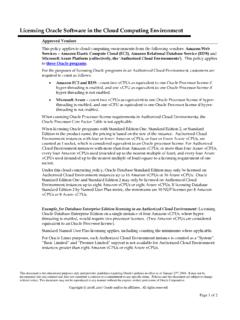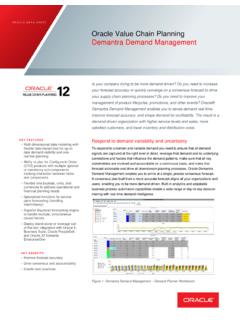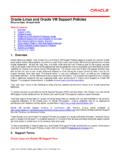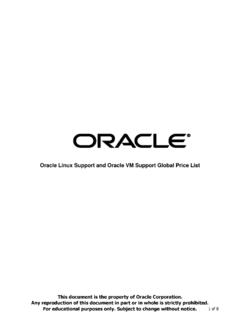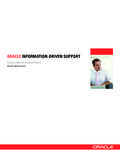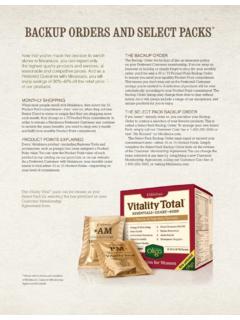Transcription of Backup and Recovery Best Practices for the Oracle …
1 Backup and Recovery best Practices for the Oracle Database Appliance An Oracle White Paper April 2014 Backup and Recovery best Practices for the Oracle Database Appliance Backup and Recovery best Practices for the Oracle Database Appliance Introduction .. 4 Backing up and Restoring Virtual Machines .. 4 Backup of Virtual Machines .. 4 Restore of Virtual Machines .. 5 Database Backup .. 5 Test Environment .. 7 General Decisions .. 7 Tape-Based Backup Strategy .. 7 Media Management Software for Tape Backups .. 8 Tape Based Backups .. 8 Disk Based Backups .. 9 RMAN Backups to Fast Recovery Area (FRA) .. 10 Oracle Database Appliance Local and External Backup Implications.
2 10 Backup Format .. 11 Performance Numbers for Local Disk Based Backup Configurations .. 12 Network-Attached Storage Backups .. 13 RMAN Backups to the Oracle ZFS Storage Appliance 7120 .. 13 Performance Numbers for ZFSSA-Based Backup Configurations 18 Engineered Systems Backup Utility .. 18 best Practices .. 19 Conclusion .. 22 Appendix: Configure Load Balanced Backups .. 23 Appendix: Sample Scripts .. 25 Tape Backup in RAC .. 25 Tape Restore for Single Instance and RAC One Node .. 25 Image copy Backup (RAC, RAC One Node and Single Instance) . 25 Image copy restores on RAC .. 26 Image restore RAC One Node and Single Instance .. 26 Backup script for Backup set.
3 26 Backup and Recovery best Practices for the Oracle Database Appliance Monitoring disk based backups .. 27 Backup and Recovery best Practices for the Oracle Database Appliance 4 Introduction Backup and Recovery of databases and systems are important to customers. Oracle offers proven solutions for backing up databases to local storage, NFS or tape. While this has been working for most customers who use the Oracle Database Appliance as database server, support of Oracle VM in ODA has opened the requirement to back up virtual machines. This whitepaper will discuss the different options and considerations for backing up databases and virtual environments. The Oracle Database Appliance is an Oracle Engineered System consisting of hardware and software that saves customers time and money by simplifying deployment, maintenance, and support of high availability database solutions.
4 Built using the world s most popular database - Oracle Database. Along with Oracle Real Applications Clusters ( Oracle RAC), the Database Appliance offers customers a fully integrated system of software, servers, storage and networking that delivers high availability database services for a wide range of custom and packaged OLTP and Data Warehousing workloads. The Oracle Database Appliance offers customers capacity-on-demand database software licensing, allowing seamless scalability from 2 to 48 processor cores without any hardware upgrades. The appliance also offers the option of deploying a virtualized platform based on Oracle VM. Support for virtualization allows customers and ISVs to build a solution-in-a-box that efficiently utilizes resources and extends capacity-on-demand licensing to both database and application workloads by leveraging Oracle VM hard partitioning.
5 Backing up and Restoring Virtual Machines Oracle Database Appliance can be set up with Oracle VM which enables you to run virtual machines from local repositories or shared repositories. Shared repositories are highly available by use of Oracle CloudFS and were introduced in Oracle Appliance Manager version The advantage of shared repositories is that in case of maintenance or a node failure the VM can be started on the other node or fail over automatically. Although you have high availability with shared repositories virtual machines need to be protected against risk of logical and physical destruction. Backup of Virtual Machines All VMs stored on local or shared repositories including ODA_BASE, which is the virtual machine that runs the databases, can be backed up using a Backup client or Linux tools to save files on an NFS mount point or tape.
6 VMs can also be saved by backing up their config file and virtual disks from dom0 using Backup and Recovery best Practices for the Oracle Database Appliance 5 normal Linux tools, like tar, cpio, rsync, scp or sftp. Complete repositories can be saved using the same Linux tools. Shared repositories are based on Oracle Cloud File System, which offers the creation of snapshots. Oracle recommends storing VMs in a shared repository, because of the switchover and automatic failover capability of VMs. While not yet supported within Oracle Appliance Manager with oakcli commands, customers can create read only snapshots themselves if the snapshot capability was licensed.
7 It takes only a few minutes to stop the VM, create a read only snapshot and then start the VM. The snapshot can be destroyed after backing up the VM files or repositories from the snapshots. Read-write snapshots are not supported on ODA. In all cases Oracle recommends to take offline backups of virtual machines. Snapshots reduce downtime of VMs dramatically. Virtual machines that do not store data on their local file systems may be backed up less often. VMs which hold data locally may need regular backups or back up their data by Backup clients. MOS note shows the various options to backing up VMs. Restore of Virtual Machines When a VM has been damaged and needs to be restored, only the files belonging to the VM need to be copied back to its original location.
8 For a completely damaged repository an import and clone of the VMs is recommended. See MOS note for details about restoring VMs. Database Backup A key operational aspect of deploying Oracle s Database Appliance is to ensure that database backups are performed so that Oracle databases that reside on the Database Appliance can be restored if disaster strikes. Changing the storage configuration of the Oracle Database Appliance from triple mirroring to double mirroring or vice versa is best secured by backing up and restoring the database. This white paper is based on Oracle Database 11g Release 2 and describes the best Practices for setting up optimal Backup and Recovery strategies to protect mission-critical data and environments.
9 The Oracle Database includes sophisticated and scalable Backup technologies. These technologies work well on the Oracle Database Appliance with its high bandwidth bonded 1 GbE and 10 GbE interfaces. The following technologies make it possible to achieve simple and reliable Backup /restore procedures on the Oracle Database Appliance: Backup and Recovery best Practices for the Oracle Database Appliance 6 Oracle Recovery Manager (RMAN) provides the native Backup and Recovery infrastructure within Oracle Database, enabling optimized data protection in the Oracle Database Appliance environments: o Backup , restore, and Recovery operations are performed using standard RMAN commands.
10 O RMAN can parallelize Backup operations across both Real Application Cluster (RAC) nodes. This allows all disks, all network connections and all CPUs in the system to contribute towards performing Backup operations. o RMAN block change tracking allows incremental backups to run very quickly and efficiently. With block change tracking, only the areas of the database that have been modified since the last incremental Backup , or full Backup , are read from disk. Oracle Secure Backup (OSB) is a centralized tape Backup management solution for the entire IT environment including file systems and Oracle Databases. With built-in RMAN integration, Oracle Secure Backup delivers the fastest Oracle Database backups to tape.
